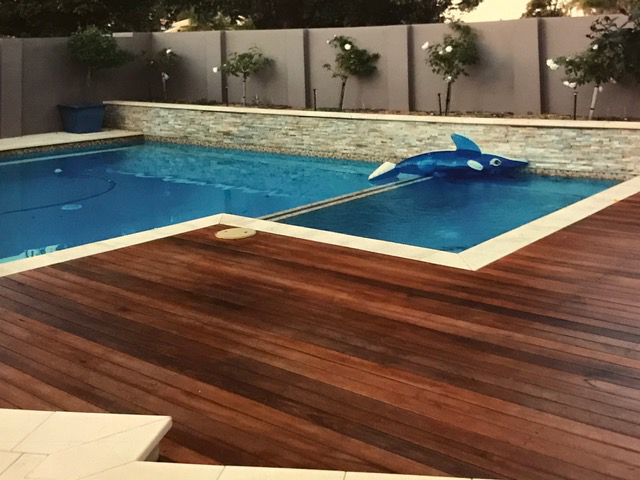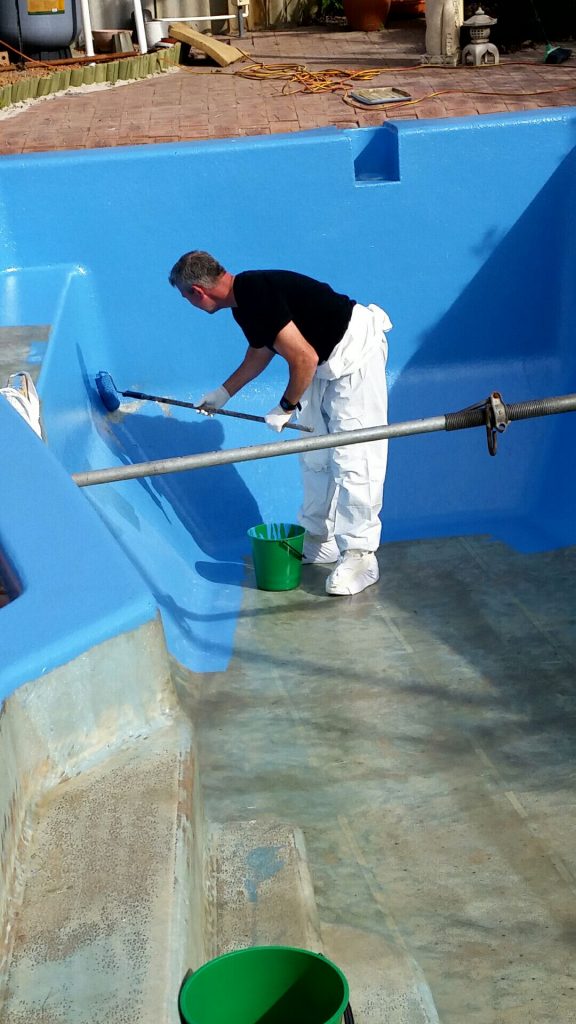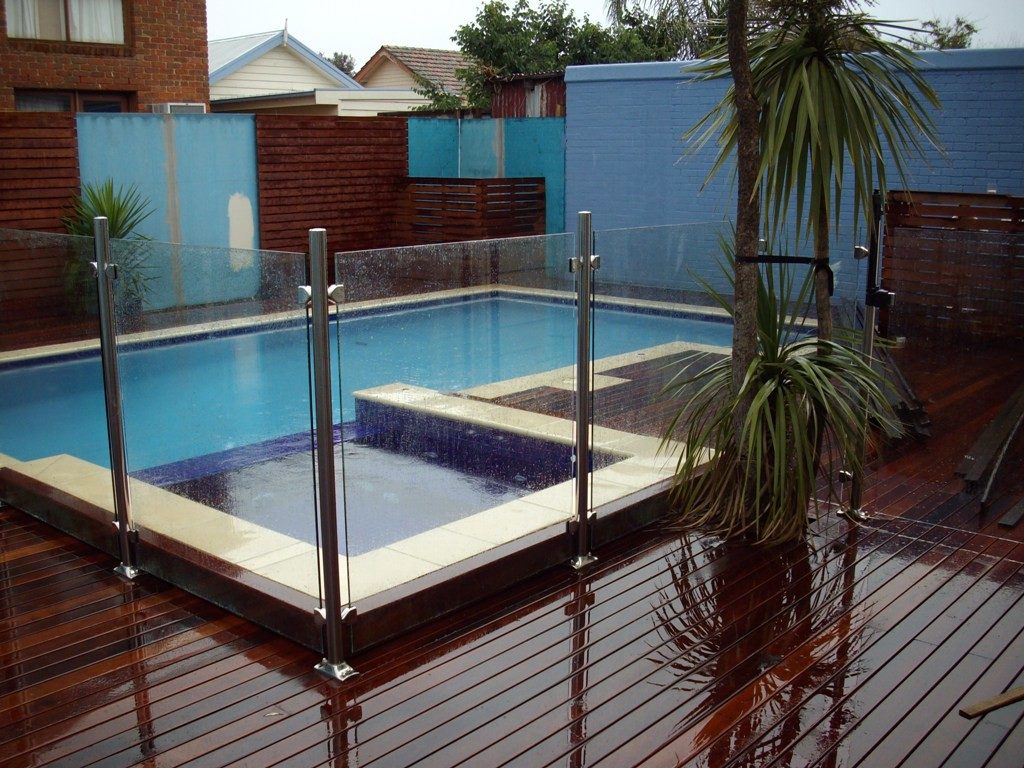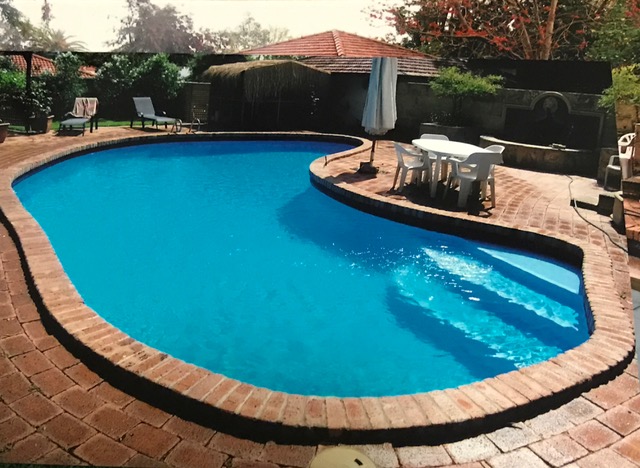
A). We have written a comprehensive downloadable PDF guide here on how to find a leak in your pool.
A). We have written a comprehensive downloadable PDF guide here on how to find a leak in your pool.
A). Concrete pools generally have more options available for a Renovation, these include:
A). Fibreglass pools generally have fewer options available for a makeover, these include:
A). Vynal liner pools generally have even fewer options available for a makeover these include:
A). Fibertech Coating system has been around for at least 25 years. Fibreglass matting is laminated over the existing plaster or fiberglass surface. Using Vynal Ester Resin, which has up to 30% flexibility to laminate chop strand matting over the entire surface of the shell this system seals the entire pool.
The Laminate then gets 3 more coloured resin coats with sanding in between to produce a beautiful surface that looks exactly like a painted pool but with the structural surface strength to prevent peeling and chalking.
With a fiberglass pool this system is always the best option, rather than just “coat only” which has no structural strength. Also it does not have any seams and wont be cut, shrink or tear like a Vynal liner. A Fibretech coating can not blister like paint, or become rough and porous.
Best Features are:
Possible negatives:
A). Pool Plaster is by far the best option when the existing plaster surface is in bad condition or when the customer is looking for a much more natural look and feel. It is absolutely recommended that all of the existing plaster be jack-hammered off prior to the application of new plaster. This ensures that you are not having to worry about the old plaster causing any issues in the future and have a good solid base to start from. Quartz finishes such as our preferred “Rainbow Quartz” have a great colour range and can also be mix-matched to customize the look of your pool, or just have it looking like an inviting beach oasis with the “Sandy Beach “ colour.
Best Features are:
Possible negatives:
A). Epoxy paint is a 2 pack paint which is resistant to chemicals such as salt and chlorine. It is easily applied with a brush or roller and is a good low cost alternative for pools that have a completely sound plaster surface and needs an easy makeover that can last a few years (with good care). Also it can be done DIY. (DIY kits are available)
Best Features are:
Possible negatives:
A). Chlorinated rubber paint is a 1 pack pool paint that is not used as often as it once was. We do not use it because it is rated for about a 3 year lifespan which doesn’t tend to suit most backyard pool users.
A). No we do not, although we can replace your vinyl liner for a fiberglass one even on sand bottom floors. Its costs about 30 % more than a quality vinyl liner but is much more durable and harder to damage.
A). When renovating your swimming pool it is a good opportunity to replace existing tiles or to incorporate more tiles into the design. These are a few options available:
A). Pool tiling is a beautiful finish both to look at and to feel, that will last for many years providing the correct adhesive is used. Fully tiled pools have always been considered the premium finish. It is possible to fully tile both fibreglass and concrete pools,
Best Features are:
Possible negatives:
A). With good weather each renovation process takes approximately the following conservative times.
| Work carried out | working days |
| Jack-hammering old plaster off Pool header pavers Waterline tiles (remove and replace) Epoxy coating (7–10 days curing included) Fibretech coating (1-3 days curing included) Replastering (always remove old plaster) Refill and balance Installing new equipment Skimmer box replacement Water features Glass Fence Install |
3-7 1-3 2-4 18 14 2-3 2-5 1-2 1-2 2-5 1-2 |
These times are as a guide only and are affected by differences in site difficulty, inclement weather, location and size of construction. We can provide written time schedules and or express service if requested at the time of quotation.
A). Every season has its positives and negatives. Although it is easier for us to work outdoors in the mild weather of spring and autumn.
A). Yes, we can extend or shorten your swimming pool to your requirements, we can even make it shallower, build new bench seats, a spa inside of it or a new set of steps.
A). No not necessarily, some stages of the process may be filling the pool, emptying the pool, coatings curing, drying time, too windy for coating, too hot for coating, too wet for coating, ect ect, where there will not be anyone on site watching the paint dry so to speak. We will however keep you informed of what is happening with your job and our shop premises is open 7 days to handle any enquiry you may have.
A). We have several types of lighting available from standard halogen lights, LED lights to fibre-optic lighting all of which can be installed retro fit to operate on a timer system for maximum effect. However mostly all the lights we install are LED which have improve greatly in recent years to become very reliable and user friendly.
Here are the benefits and possible negatives of these different lighting types
1). Quartz halogen lights (12 volt)
Benefits
Possible negatives
2). LED lights (12 volt)
Benefits
Possible negatives
3). Fibre optic lights
Benefits
Possible negatives
A). If you are taking up old pavers or concrete around the pool then it is definitely worthwhile replacing your old pipe-work at this stage especially on 20 year old plus pools. Otherwise PVC pipe-work is very hardy if laid correctly and rarely needs replacing. Return jets are easy to replace and is recommended on most pool renovations mainly just for ascetic reasons alone. The correct method of laying new pipe-work should involve priming all joints and using preferably “green” PVC glue followed by pressure testing to ensure no leaks.
A). This all depends on whether you have a fiberglass or concrete pool.
Concrete pools that are being re-plastered can be emptied at the beginning of a yard makeover and have the old plaster jack hammered off whilst other works are taking place. If there is machinery being used to clear a block, consideration for safety of the machine operator must be considered. The pool may need to be emptied and covered to prevent a machine operator from drowning should a machine topple into the pool.
Order of Works (Concrete Plaster)
1). Demolition and clearing of block and structures being replaced/removed.
2). Jackhammer off old plaster.
3). Hardscaping such as retaining wall and patios.
4). Install new Skimmer box if required
5). Run new pipe-work and light cables to new or existing equipment area.
6). Install Bull-nose pavers and new tile line
7). Paving of yard and soft-scaping with the installation of plants ect.
8). Install new pool fencing or reinstate old
9). Cleanout and plaster swimming pool, acid wash surface and commence filling.
10). Install pool equipment and new lights, jets and fittings
11). Balance water and commission pool
Fibreglass pools are best recoated midway in a yard makeover then headers and then paving/landscaping, due to any movement that may occur in the surrounding sand from empting and refilling. If there is machinery being used to clear a block, consideration for safety of the machine operator must be considered. The pool must be left filled and covered to prevent a machine operator from drowning should a machine topple into the pool.
Order of Works (Fibreglass Pool)
1). Demolition and clearing of block and structures being replaced/removed.
2). Hardscaping such as retaining wall and patios.
3). Recoating of fiberglass
4). Run new pipe-work and light cables to new or existing equipment area.
5). Install temporary fencing if required
6). Install new Skimmer box if required and refill pool.
7). Install pool equipment.
8). Balance water and commission pool
9). Install Bull-nose pavers
10). Paving of yard and soft-scaping with the installation of plants and permanent pool fence.
You should only have your pool emptied by an expert who knows how to empty your pool safely (it may also require bracing). The pool should be left empty for as little time as possible and should be refilled at the completion of the renovation in a timely manner. (It may void your warranty if left unfilled for any extra period of time).
It costs about $1.20 per 1,000ltrs of water and the average pool holds about 50,000ltrs of water which equates to $60.00. Also the average yearly usage of a household is about 300,000ltrs. You can save your pool water for re-use in storage tanks although it will cost far more than $50.00 and you will need lots of room in your yard to store this water so unfortunately it is not a viable option at this stage for everyone.
The typical life span of the sand in your filter according to SPASA is 3 to 5 years or every 12 months in a commercial swimming pool. What happens to the sand in the filter after time is that it becomes hard and causes an affect that is called channeling. When this occurs the water is going through holes that have been made by the water and is not actually filtering effectively through the sand. It is best to change your sand when you get your pool recoated if you believe it may require doing.
Yes we do provide DIY kits for epoxy paint and can guide you through this process. Fibretech and re-plastering is more difficult and requires a degree of expertise in the relative fields.
Blue Star Pools offer a regular pool service to look after your pool and keep it perfectly maintained and chemically balanced all year round. This is the best way to ensure your new pool stays looking new for as long as possible.
There is generally 4 options available for your heating options these are
Here are the benefits and possible negatives of these different lighting types
1). Solar blanket
Benefits
Possible negatives
2). Roof solar heating
Benefits
Possible negatives
3). Gas heating
Benefits
Possible negatives
4). Heat Pump
Benefits,
Possible negatives
Any pool can be converted to salt without any problems apart from metal framed above ground pools which can be affected by increased corrosion. All salt water conversions require installing a “salt water chlorinator control box and electrode” commonly referred to as a “power supply and cell”. Salt is then added to the pool water and the power supply and cell uses this to produce “chlorine gas” which sanitises the water. So in effect when you convert to a salt water system you are basically producing your own chlorine at home rather than purchasing it. This will lead to cost savings, less maintenance and better water quality. The best salt water chlorinator units are “Self Cleaning” where the salt electrode (the part of the chlorinator that produces the chlorine gas) reverses polarity every 2 hours or so to prevent calcium build up on the electrode plates (cathodes and anodes). This saves even more maintenance time and results in more efficient chlorine production. In my opinion Salt water chlorinators are far more practical than liquid chemical feeders, that tend to be more complicated, require more maintenance and are more expensive to run.



